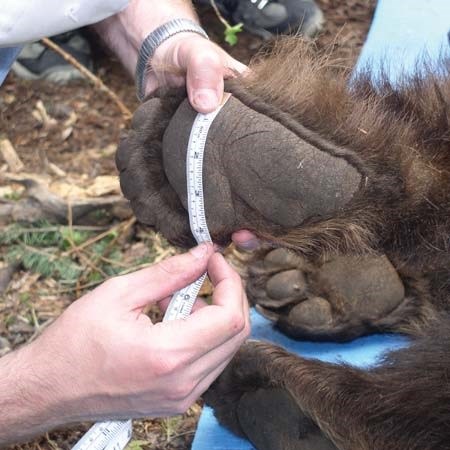Last updated: November 8, 2022
Article
Black Bear Population and Stability

The Question: What is the population size and stability of black bears in the park?
Black bears can be found throughout much of North America. In most places the number of black bears is stable or increasing. However, data collected from 1985-1991 showed that Rocky Mountain National Park’s population of black bears was only around 20 and had one of the lowest densities and reproductive rates ever recorded. The scientists attributed this to the park’s large percentage of tundra and high alpine forests, which provide little of the nutritional foods like berries that bears prefer. With such low estimated bear numbers, reproductive rates, and available habitat, managers wanted to learn more about the size, stability, and health of the park’s black bear population.The Project: Use extensive trapping and telemetry, remote cameras, den checks, and bear sightings to determine bear population size and stability.
Roger Baldwin and Louis Bender of the New Mexico Cooperative Fish and Wildlife Research Unit designed a study using various techniques to monitor the black bears. First researchers snared bears, anesthetized, and radio collared them for use in telemetry tracking. Second researchers placed remote cameras fi ve kilometers apart throughout the park in order to identify uncollared bears. Lastly they used visitor reports of bears to help identify additional bears not collared or photographed. The researchers also checked dens to determine cub numbers and survival.
The Results: Total population of bears in the park is estimated to be 20-24 bears.
Investigators captured and radio collared a total of 14 bears. Of these bears, four were adult males, four adult females, two subadult (one to three years) males, and four were subadult females. Remote cameras in the park identifi ed fi ve additional bears on the west side of the Continental Divide and six on the east side. Coupled with visitor reports of bear sightings, the minimum population of black bears in the park is between 20 and 24. The team documented four mortalities during the study, with two occurring through legal harvest on adjacent properties, while causes of the other two mortalities were unknown. The resulting survival rate for all bears from 2003-2006 was 93%. Sixteen cubs were observed during historic and contemporary studies averaging 1.8 cubs/litter. In the 1985-91 study only 43% of cubs in the park survived. However cub survival during this study was 71%.Although the study found that black bears in the park still had one of the lowest densities ever recorded, it suggested that the population could exhibit substantial growth in the next 10 years. Also bears in the park have become heavier and are in better nutritional condition since the 1985-91 study, possibly due to increased use of anthropogenic
(human) food sources. This is also suggested by the fact that bears are incorporating more human-use areas in their home ranges than in years past. However bears that become habituated to human foods can become more aggressive in their eff orts to obtain these food sources, and this situation usually results in the euthanization of problem bears.
This summary is based on published, peer-reviewed and/or unpublished reports available at the time of writing. It is not intended as a statement of park policy or as a defi nitive account of research results. For more information on the park’s research program, see www.nps.gov/romo
Written by: Darin Newton Date: June 2007 Updated: January 2008 Photo credit: NPS-RMNP
